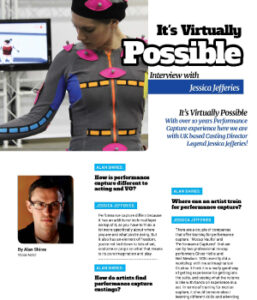 It All Started with Jessica Jefferies
It All Started with Jessica Jefferies
This was an area of the industry I discovered in my mid-twenties and prior to that, I was oblivious to it. Backing up a bit, in the last two decades mocap has really come into its own but certainly, in the last ten years from a performer’s perspective, this area has exploded. When I discovered it, I fell instantly in love because I felt that my theatrical training had a place outside of the theatres and in a filming studio-type environment. You can read multiple blogs and interviews I have done on performance capture and motion capture but this Jessica Jefferies interview is where it all started.
Revisiting the Drawing Board as an Artist
When I carried out this interview, it was on the back of a weekend event in London called Get Your Game On. Jessica was running an intensive course which I knew I must attend. This is where my mocap and performance capture journey began, and I have not looked back. The beauty was I did not need to think all that hard about what to ask Jessica for the article because I was too hungry to know as much as I could about working in mocap and performance capture that I was not short of questions. I knew adding mocap and performance capture to my belt was essential but in addition to that I was starting all over again in a new field, looking at the drawing board whilst I learn and develop in this area.
Knowing Who’s Who
Breaking out of our specific fields of work (In this instance voice over) can be tricky. There is so much going on how do we add more to the pile? I soon learnt that the setup was the same in that clients went to casting directors who became gatekeepers of the work. Jessica Jefferies spoke at this particular event, and I was volunteering, so I got to chat with her a fair bit. What makes her position as a casting director unique is that she had worked as a performer in mocap and performance capture for years but wanted to now help more talent get into the industry and help companies draw in a better yield of talent for their projects. At this point, there was not even an agent in the UK specifically for performance capture (There is now). There is only a small number of casting directors in the UK that specialise in mocap and performance capture specifically it’s common for the larger acting agencies to represent artists who are going into performance capture and mocap.
Three Things the Jessica Jefferies Interview Showed Me
Jessica said some very interesting things in the interview, but one of my highlights is her three top tips for actors and voiceover artists to adapt. Those three things are imagination, taking direction quickly, and breathing. I will use the rest of this blog to break down each of these three points they are all massively important in their own right, and I see them as a critical force to success in performance capture and mocap. Remember, I am coming at this from an actor and voiceover artist perspective, not an established regularly working performance and motion capture performer perspective.
Using Imagination
Whether it be on stage, in front of a lens, or behind the mic, imagination is key! Be you carrying out an acting gig or a voice over job, you must use your imagination as it is vital across the entire industry. I often ask my students to tell me what just happened in the scene they are reading from before the first line, they have to make it up! I ask them to describe the situation their character is performing in. The detail is vital, the smell, the temperature, what’s on the walls, how loud it is outside, and anything else they can imagine. We want to get to a place as a performer where we are totally submerged into the imagined environment we have made to deliver a truthful, fresh, and unique performance that will catch the casting directors’ eyes.
Taking Direction Quickly
We know we need to take direction; it’s a massive part of the job. Sculpting our performance around the words given by casting hopes to produce a performance that reflects the characteristics displayed only in their mind. It can be a bit of guesswork, but the key thing here is the word quickly. We have to adapt our performance by implementing their feedback quickly. Why is this? Well, casting professionals often see hundreds of actors, and the first thing is they don’t have time to spoon-feed actors they need the finished package. The second reason is that adapting quickly shows them you can react fast on set and will be able to pull off what is asked of them when it comes to direction.
Adapting Differently to Breathing
It took me years to realise the importance of breath in performance capture and motion capture. As a performer, we know the importance of breathing! In voice over it gets tidied up a lot in the edit, and on-screen, it’s fairly subtle. In performance and motion capture, you have to breathe big! In these skin-tight suits, the censors will pick up every little movement, and the bigger the breaths, the better the digitalized character looks. Also, the breath is a character’s signature! A military officer running will have big breaths but thinks about a dragon; how does a dragon breathe? Well, these are elements we must bring into performance capture auditions.